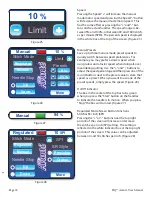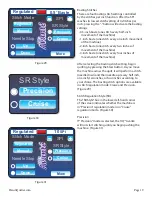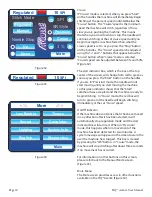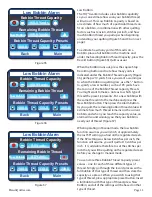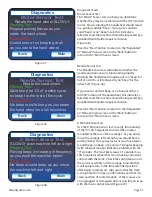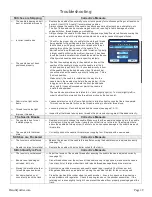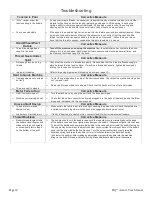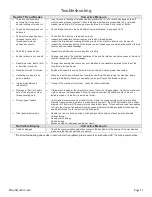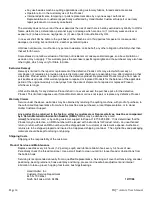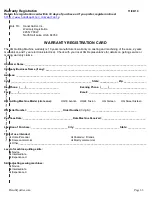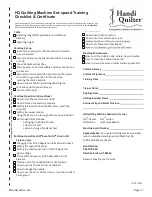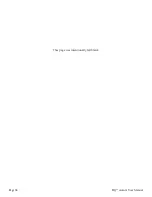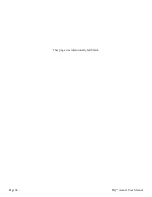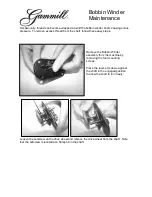
HandiQuilter.com
Page 27
In regulation mode the status box at the top left
of the screen should say “Regulated”. If it says
“Manual”, simply press the “Regulated” button on
the touch screen to switch from “Manual” mode to
“Regulated” mode.
IMPORTANT NOTES ABOUT TURNING STITCH-
REGULATION ON OR OFF
You can stop the machine at any time by pushing
either the “Start/Stop” or the “Needle Up/Down”
key on the handles. In Cruise Regulation mode, if
you don’t move the machine after 3 or 4 seconds,
the machine will stop and position the needle. In
Precision Regulation mode, the needle pauses
when you stop moving the machine and will begin
stitching again when you start moving the machine.
Press the “Start/Stop” (or “Needle Up/Down”) key
in Precision Regulation mode to stop the needle
completely and cause the needle to position itself in
the Needle Up or Down position.
Cruise Regulation Mode
When in Cruise Regulation mode, the start indicator
box in the top center of the “Regulated” screen is
red. When you press the “Start/Stop” key to start
the machine, the indicator will turn green AND the
needle will begin moving up and down.
The minimum speed of the needle is dependent upon
the setting you choose (from 3% to 50%). Handi
Quilter recommends beginning with a setting of 3%.
When to Use Cruise Regulation Mode
The constant minimum stitching speed featured
in the Cruise Regulation mode is used for precise
placement of stitching when backtracking (such as
along the tops of feathers) or when creating sharp
points (such as the point of a star or the bottom of a
heart).
Precision Regulation Mode
When in Precision Regulation mode, the start
indicator box in the top center of the “Regulated”
screen is red. When you press the “Start/Stop” key to
start the machine, the indicator will turn green. As
you start moving the machine, it will begin stitching.
HQ STITCH REGULATOR OPERATION
Choose from Two Types of Stitch Regulation: Cruise or Precision
When you stop moving the machine, the needle
pauses (sometimes in mid-stroke.)
When you press the “Start/Stop” (or “Needle Up/
Down”)key to stop the machine, the indicator will
turn red, showing that the needle will not move
when you move the machine.
Always make sure the indicator is RED when you
are in Precision Regulation mode prior to working
with your hands near the needle (changing the
needle, replacing the bobbin, etc.) to avoid unwanted
stitching in your quilt or your hands!
If you leave the HQ
18
Avanté in Precision Regulation
mode with the start indicator box green and do
not move the machine for two minutes, the system
will “time-out” and a message box will appear. This
indicates that the system has stopped and you will
need to press the “Start” button again to resume
quilting.
When to Use Precision Regulation Mode
Precision Regulation mode is especially useful for
ruler work. Stitch along the length of the ruler
for the span of your hand and stop. When you stop
moving the machine, the needle pauses. Do not turn
off the machine. Move the ruler and commence
quilting. The Precision Regulation helps you avoid
“bobbles” and uneven stitches.
Quilting Speed While in Stitch-Regulation Mode
It is important not to move the machine too
fast, since this will result in an OVERSPEED
CONDITION, during which, the machine cannot
maintain stitch regulation until you slow your
motions to an appropriate speed. The Overspeed
Alarm will alert you to this condition, giving you the
signal to slow down. Stitch regulation is not a license
to move the machine as fast as you can. Its purpose
is to maintain even stitches while quilting at an
appropriate speed.
You can return to manual mode by pushing the
“Manual” button below the “Regulated” button on
the touch screen display.
Содержание Avante QM30235
Страница 1: ...USER MANUAL 04 18 14 2014 Handi Quilter Inc Avanté 18 QM30235 version 2 0 ...
Страница 32: ......
Страница 36: ...Page 36 HQ18 Avanté User Manual This page was intentionally left blank ...
Страница 38: ...Page 38 HQ18 Avanté User Manual This page was intentionally left blank ...
Страница 39: ...Page 38 HQ18 Avanté User Manual This page was intentionally left blank ...






